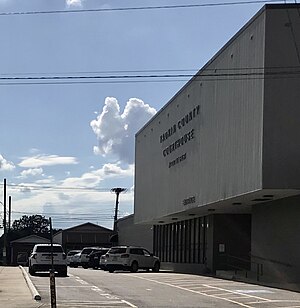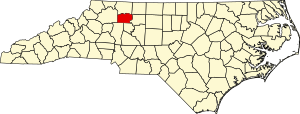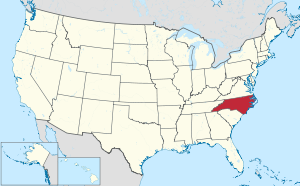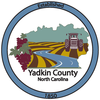Yadkin County is a county located in the U.S. state of North Carolina. As of the 2020 census, the population was 37,214.[1] Its county seat is Yadkinville.[2] Yadkin County is included in the Winston-Salem, NC Metropolitan Statistical Area, which is also included in the Greensboro–Winston-Salem–High Point, NC Combined Statistical Area.
Yadkin County | |
|---|---|
 Yadkin County Courthouse | |
| Motto(s): "Come for a visit, stay for a lifetime" | |
 Location within the U.S. state of North Carolina | |
 North Carolina's location within the U.S. | |
| Coordinates: 36°10′N 80°40′W / 36.16°N 80.67°W | |
| Country | |
| State | |
| Founded | 1850 |
| Named for | Yadkin River |
| Seat | Yadkinville |
| Largest community | Yadkinville |
| Area | |
• Total | 337.71 sq mi (874.7 km2) |
| • Land | 334.94 sq mi (867.5 km2) |
| • Water | 2.77 sq mi (7.2 km2) 0.82% |
| Population (2020) | |
• Total | 37,214 |
• Estimate (2023) | 37,774 |
| • Density | 111.11/sq mi (42.90/km2) |
| Time zone | UTC−5 (Eastern) |
| • Summer (DST) | UTC−4 (EDT) |
| Congressional district | 5th |
| Website | www |
History
editWhat is now Yadkin County was home to the Tutelo and Saponi Indian tribes.[3] European-descent settlers moved into the area around 1748. Though in a part of the Piedmont region of the state, the residents of the eventual county developed more economic, political, and cultural similarities with their contemporaries in the mountains to the west than to many of their peers in other sections of the Piedmont or those in the eastern part of North Carolina.[4] Over the following decades the county developed as a society mostly made up of smallholding white farmers, though Yadkin was also home to several large landowners and slaveholders (and their slaves), some working professionals, and a few free blacks and Native Americans.[5]
The land eventually comprising Yadkin County was first politically organized under the jurisdiction of Anson County.[4] In 1750, it was placed in the new jurisdiction of Rowan County, and in 1770 was made a part of Surry County. In 1850, the North Carolina General Assembly split off the portion of Surry south of the Yadkin River to create Yadkin County to satisfy local political divisions.[6] At the time of its creation, the county had 9,808 residents, of whom 8,664 were white, 86 were free persons of color, and 1,508 were enslaved blacks.[7] The town of Wilson was established to serve as the county seat. In 1852 the town's name was changed to Yadkinville.[8]
From 1850 to 1860 the county experienced economic and demographic growth. By the end of the decade, though it was still mostly rural and dominated by farming, the county hosted several grist mills, stores, distilleries, and a tobacco factory.[9] Politically, the county was home to many Whigs and its resident favored John Bell of the Constitutional Union Party during the 1860 United States presidential election.[10] Following the election of Republican Abraham Lincoln as president, leaders of the state of North Carolina considered whether or not to secede in 1861 and join the nascent Confederate States of America. Yadkin voters overwhelming rejected a vote to hold a state convention to consider secession.[11][12] Following Lincoln's call for Southern volunteers to suppress rebellion in South Carolina, a state convention was held and North Carolina seceded from the United States.[13]
Men from Yadkin County served during the ensuing American Civil War in the Confederate States Army. Many would desert and return home to assist their families in key agricultural activities before going back into service.[14] North Carolina's declaration of a draft proved unpopular in the county;[15] some locals avoided conscription into the army due to pro-Union sentiments, or, in the case of local Quakers, due to religious objections to war and slavery. Some draft dodgers hid in woods or caves, while others fled west to pro-Union communities in the mountains.[16] In February 1863, two Confederate officials and two draft evaders were killed in an exchange of gunfire after a militia attempted to arrest a group of evaders at a school house.[17][18]
After the war, Yadkin became politically dominated by the Republican Party, with many locals being attracted to it for its opposition to slavery, support for central national government, and push for disbursing money to fund infrastructure improvements.[19] Yadkin's support for the Republican Party persisted along with some of its neighboring counties after the state largely fell under the Democratic Party's domination in the 1870s.[20] Portions of Yadkin County were annexed to Forsyth County in 1911 and 1927.[21] The county garnered its first paved highways in the 1920s.[22]
By the mid-20th century, Yadkin's economy was largely rooted in tobacco farming. Many residents not employed by the agricultural industry commuted to Winston-Salem in Forsyth County for work. In 1971, Unifi Manufacturing established its first textile facility in Yadkin County. As the company expanded over the following decades, it became the leading industrial employer the county and provided additional economic support through tax revenue and philanthropy to the area. National declines in the textiles industry in the late 1990s and early 2000s led the company to shrink its local presence.[23]
Geography
editAccording to the U.S. Census Bureau, the county has a total area of 337.71 square miles (874.7 km2), of which 334.94 square miles (867.5 km2) is land and 2.77 square miles (7.2 km2) (0.82%) is water.[24] It is bordered by Surry, Forsyth, Davie, Iredell, and Wilkes counties.[3]
Yadkin County is located in the Piedmont region of North Carolina and in the northwestern portion of state, close to the Blue Ridge Mountains.[3] The western portions of the county are hillier than the eastern portions,[4] with part of the Brushy Mountains crossing into the northwestern section.[25] It is within the Yadkin-Pee Dee River Basin,[3] with the Yadkin River forming its northern and eastern borders.[26]
State and local protected areas
editMajor water bodies
editDemographics
edit| Census | Pop. | Note | %± |
|---|---|---|---|
| 1860 | 10,714 | — | |
| 1870 | 10,697 | −0.2% | |
| 1880 | 12,420 | 16.1% | |
| 1890 | 13,790 | 11.0% | |
| 1900 | 14,083 | 2.1% | |
| 1910 | 15,428 | 9.6% | |
| 1920 | 16,391 | 6.2% | |
| 1930 | 18,010 | 9.9% | |
| 1940 | 20,657 | 14.7% | |
| 1950 | 22,133 | 7.1% | |
| 1960 | 22,804 | 3.0% | |
| 1970 | 24,599 | 7.9% | |
| 1980 | 28,439 | 15.6% | |
| 1990 | 30,488 | 7.2% | |
| 2000 | 36,348 | 19.2% | |
| 2010 | 38,406 | 5.7% | |
| 2020 | 37,214 | −3.1% | |
| 2023 (est.) | 37,774 | [1] | 1.5% |
| U.S. Decennial Census[28] 1790–1960[29] 1900–1990[30] 1990–2000[31] 2010[32] 2020[1] | |||
2020 census
edit| Race | Number | Percentage |
|---|---|---|
| White (non-Hispanic) | 30,357 | 81.57% |
| Black or African American (non-Hispanic) | 1,071 | 2.88% |
| Native American | 63 | 0.17% |
| Asian | 142 | 0.38% |
| Other/Mixed | 1,199 | 3.22% |
| Hispanic or Latino | 4,382 | 11.78% |
As of the 2020 census, there were 37,214 people, 15,425 households, and 10,789 families residing in the county.
2000 census
editAt the 2000 census,[34] there were 36,348 people, 14,505 households, and 10,588 families residing in the county. The population density was 108 people per square mile (42 people/km2). There were 15,821 housing units at an average density of 47 units per square mile (18 units/km2). The racial makeup of the county was 92.54% White, 3.43% Black or African American, 0.16% Native American, 0.17% Asian, 0.02% Pacific Islander, 2.91% from other races, and 0.77% from two or more races. 6.48% of the population were Hispanic or Latino of any race.
There were 14,505 households, out of which 32.10% had children under the age of 18 living with them, 60.00% were married couples living together, 9.00% had a female householder with no husband present, and 27.00% were non-families. 24.00% of all households were made up of individuals, and 10.50% had someone living alone who was 65 years of age or older. The average household size was 2.47 and the average family size was 2.92.
In the county, the population was spread out, with 24.00% under the age of 18, 7.50% from 18 to 24, 30.20% from 25 to 44, 24.20% from 45 to 64, and 14.20% who were 65 years of age or older. The median age was 38 years. For every 100 females there were 96.40 males. For every 100 females age 18 and over, there were 93.60 males.
The median income for a household in the county was $36,660, and the median income for a family was $43,758. Males had a median income of $29,589 versus $22,599 for females. The per capita income for the county was $18,576. About 7.10% of families and 10.00% of the population were below the poverty line, including 10.90% of those under age 18 and 17.40% of those age 65 or over.
Law and government
editGovernment
editYadkin County is governed by a five-member board of commissioners who are elected at-large to serve staggered two- and four-year terms. Elections are held in November of even-numbered years.[35] The commissioners appoint a county manager, who serves as the head administrator of the county government.[36]
Yadkin County is a member of the Northwest Piedmont Council of Governments, a regional planning association.[37] It is located entirely in the North Carolina Senate's 36th district, the North Carolina House of Representatives' 77th district,[38] and North Carolina's 5th congressional district.[39]
Yadkin County lies within the bounds of North Carolina's 34th Prosecutorial District, the 23rd Superior Court District, and the 23rd District Court District.[40]
Politics
edit
| ||||||||||||||||||||||||||||||||||||||||||||||||||||||||||||||||||||||||||||||||||||||||||||||||||||||||||||||||||||||||||||||||||||||||||||||||||||||||||||||||||||||||||||||||||||||||||||||||||||||||||||||||||||||||
Yadkin County began supporting the Republican Party in the aftermath of the American Civil War.[42] Like some its neighboring counties, Yadkin's support for Republicans continued while the state was politically dominated by Democrats from the 1870s into the latter part of the 20th century.[20] Republicans won every county election in the 20th century except in 1958, when Democrats won the sheriff's office and all seats on the county commission in response to the incumbent commissioners' decision to demolish the county's antebellum courthouse and replace it with one the public viewed as unsightly.[43] Yadkin's support for the Republican Party carried into the 21st century with the party's rebound across the state.[20] As of March 2022, the county was home to approximately 25,000 registered voters, of whom 56.9 percent were registered Republicans and 13.4 percent were registered Democrats.[44]
Economy
editUnifi Manufacturing, a textile company, is the largest private employer in Yadkin County and operates a large recycled plastics polymer plant in Yadkinville.[45]
Transportation
editMajor highways
editTwo major four-lane highways serve Yadkin County. Interstate 77 runs north to south in the western part of the county and U.S. Highway 421 runs east to west. The two highways intersect near Hamptonville. The county also is served by U.S. Highway 21, which runs mostly parallel with I-77, and U.S. Highway 601, which runs through Yadkinville and Boonville. North Carolina Highway 67 is another popular artery that links the northern part of the county with Jonesville-Elkin and Winston-Salem.
Airports
editCommercial flights are available through Piedmont Triad International Airport and Charlotte Douglas International Airport. Two private airports are located in the county, Swan Creek near Jonesville and Lone Hickory near Yadkinville. One additional airport is located in Boonville on Baptist Church Road. It recently housed NC Baptist Hospital's AirCare II during a transitional period.
Public transportation
editBeginning in 2006, the Piedmont Authority for Regional Transportation (PART) began offering limited bus service between Boone, North Carolina and Greensboro, North Carolina as part of its US 421 Mountaineer Express.[47] The buses make stops east and west in Yadkinville.
Yadkin Valley Economic Development District Inc. (YVEDDI), a community action agency based in Boonville, operates a multi-county rural public transportation system.
Education
editYadkin County has three high schools, Forbush, Starmount, and the Yadkin Early College.
The Yadkin Early College is a five-year program where high school and college courses are offered on the Yadkin campus of Surry Community College. Students get the opportunity to earn their high school diploma and an associate degree in nursing, criminal justice, or a transfer degree to a four-year university.
The high schools are fed by eight elementary schools, which teach kindergarten through sixth grades. The eight elementary schools are Boonville, Courtney, East Bend, Fall Creek, Forbush, Jonesville, West Yadkin and Yadkinville.
The school system also operates Yadkin Success Academy, an alternative learning center on Old U.S. 421 in Yadkinville.
Yadkin County opened two new middle schools in 2009. Starmount Middle School opened in August and serves seventh and eighth grade students from Jonesville, Boonville, and West Yadkin Elementary Schools. Forbush Middle opened in November and serves East Bend, Forbush Elementary, Fall Creek, Courtney, and Yadkinville Schools. Both campuses are adjacent to the high schools.
Surry Community College offers courses through its Yadkin Campus at 4649 U.S. Highway 601 North near Yadkinville.[48]
Media
editYadkin County is covered by two community newspapers, The Yadkin Ripple and The Tribune of Elkin. The Winston-Salem Journal, a larger daily paper, also covers the county. Yadkin Valley Living, a bimonthly lifestyles publication, is based in East Bend.
Broadcast
editWSGH, an AM Spanish contemporary station, broadcasts from eastern Yadkin County.
Yadkin County is part of the Piedmont Triad radio and television market but many broadcasts from the Charlotte market also can be received.
Yadkin Valley wine region
editAll of Yadkin County is included in the Yadkin Valley AVA, an American Viticultural Area recognized by the United States government as a unique grape-growing region. Wines made from grapes grown in this area may use the appellation "Yadkin Valley" on the label. Yadkin County is also home to the second North Carolina AVA, the Swan Creek Wine Region.
Communities
editTowns
edit- Boonville
- East Bend
- Jonesville
- Yadkinville (county seat and largest community)
Townships
editUnincorporated communities
editFormer towns
editThese towns were incorporated at one time:[49]
- Arlington, merged with Jonesville in 2001
- Hamptonville, chartered in 1818
- Huntsville, incorporated in 1792
- Shore, incorporated from 1903 to 1911
- Smithtown, incorporated in 1924
Notable people
edit- Leo Arnaud, French-born film composer
- Thomas Lanier Clingman, U.S. senator and representative and Confederate brigadier general
- William "Mo" Cowan, U.S. senator for Massachusetts in 2013
- William Wade Hampton (1858–1930), state senator and state representative[50]
- Mamrie Hart, YouTube celebrity
- Dickie Hemric, basketball star for Wake Forest and the Boston Celtics
- Richmond Mumford Pearson, North Carolina Supreme Court chief justice, and his son, Richmond Pearson, a diplomat and U.S. representative
- Richard Clauselle Puryear, U.S. congressman
- Ernie Shore, a Major League baseball pitcher and former Forsyth County sheriff
- Junior Johnson (Robert Glenn), NASCAR Hall of Fame driver and champion team owner
See also
editReferences
edit- ^ a b c "QuickFacts: Yadkin County, North Carolina". United States Census Bureau. Retrieved March 22, 2024.
- ^ "Find a County". National Association of Counties. Retrieved June 7, 2011.
- ^ a b c d Bayley, Elizabeth (2006). "Yadkin County". NCPedia. North Carolina Government & Heritage Library. Retrieved May 14, 2023.
- ^ a b c Casstevens 2015, p. 10.
- ^ Casstevens 2015, pp. 11, 17.
- ^ Casstevens 2015, p. 11.
- ^ Casstevens 2015, p. 12.
- ^ Corbitt 2000, p. 238.
- ^ Casstevens 2015, pp. 11, 17–18.
- ^ Casstevens 2015, pp. 20–21.
- ^ Casstevens 2015, pp. 21–22.
- ^ Auman 2014, p. 30.
- ^ Casstevens 2015, pp. 22–23.
- ^ Casstevens 2015, p. 7.
- ^ Auman 2014, pp. 38, 47.
- ^ Casstevens 2006, p. 16.
- ^ Casstevens 2006, pp. 18–19, 22.
- ^ Auman 2014, p. 66.
- ^ Casstevens 2015, pp. 8, 20, 81.
- ^ a b c Auman 2014, p. 213.
- ^ Corbitt 2000, p. 239.
- ^ Casstevens 1996, p. 26.
- ^ Romoser, James (December 18, 2005). "Unifi, Yadkin cope with end of 'glory days'". Winston-Salem Journal. pp. A1, A8.
- ^ "2020 County Gazetteer Files – North Carolina". United States Census Bureau. August 23, 2022. Retrieved September 10, 2023.
- ^ Casstevens 1996, p. 9.
- ^ Casstevens 2015, pp. 9–10.
- ^ "South Yadkin River". www.deq.nc.gov. 2008. p. 2. Retrieved June 15, 2023.
- ^ "U.S. Decennial Census". United States Census Bureau. Retrieved January 20, 2015.
- ^ "Historical Census Browser". University of Virginia Library. Retrieved January 20, 2015.
- ^ Forstall, Richard L., ed. (March 27, 1995). "Population of Counties by Decennial Census: 1900 to 1990". United States Census Bureau. Retrieved January 20, 2015.
- ^ "Census 2000 PHC-T-4. Ranking Tables for Counties: 1990 and 2000" (PDF). United States Census Bureau. April 2, 2001. Archived (PDF) from the original on March 27, 2010. Retrieved January 20, 2015.
- ^ "State & County QuickFacts". United States Census Bureau. Retrieved October 30, 2013.
- ^ "Explore Census Data". data.census.gov. Retrieved December 20, 2021.
- ^ "U.S. Census website". United States Census Bureau. Retrieved January 31, 2008.
- ^ "County Commissioners". Yadkin County. Yadkin County Government. Retrieved May 16, 2023.
- ^ "County Manager". Yadkin County. Yadkin County Government. Retrieved May 16, 2023.
- ^ "Who We Are and What We Do". Piedmont Triad Regional Council. Retrieved May 17, 2023.
- ^ "Yadkin County Representation : 2023-2024 Session". North Carolina General Assembly. Retrieved May 16, 2023.
- ^ Doyle, Steve (November 7, 2022). "Here's the rundown of North Carolina's and the Triad's most important races for Election Day 2022". FOX8 WGHP. Nexstar Media Group. Retrieved May 21, 2023.
- ^ "Yadkin County". North Carolina Judicial Branch. Retrieved May 16, 2023.
- ^ Leip, David. "Dave Leip's Atlas of U.S. Presidential Elections". uselectionatlas.org. Retrieved March 17, 2018.
- ^ Casstevens 2015, pp. 8, 81.
- ^ Hobson 2006, p. 45.
- ^ Doyle, Steve (March 28, 2022). "NC election season begins with more voters unaffiliated". FOX8 WGHP. Nexstar Media Group. Retrieved May 16, 2023.
- ^ Craver, Richard (November 4, 2022). "Apparel slump at retail sends Unifi to first-quarter 2023 loss; share price closes down 24.2%". Winston Salem Journal. Retrieved January 12, 2023.
- ^ Harrison, Kristy Burns (September 7, 2022). "Yadkin Commissioners support future interstate plans". The Yadkin Ripple. Retrieved May 17, 2023.
- ^ Piedmont Regional Transportation Authority Website Archived June 1, 2007, at the Wayback Machine
- ^ "Off-Campus Centers". Surry Community College site. Archived from the original on October 7, 2011. Retrieved July 2, 2011.
- ^ The Heritage of Yadkin County, Frances Harding Casstevens, editor, Page 9
- ^ "Former Legislator Dies in Surry". The News & Observer. December 15, 1930. p. 2. Retrieved November 12, 2024 – via Newspapers.com.
Works cited
edit- Auman, William T. (2014). Civil War in the North Carolina Quaker Belt: The Confederate Campaign Against Peace Agitators, Deserters and Draft Dodgers. McFarland. ISBN 9781476612997.
- Casstevens, Frances H. (2015). The Civil War and Yadkin County, North Carolina. McFarland. ISBN 9781476604039.
- Casstevens, Frances H. (2006). Tales from the North and the South: Twenty-Four Remarkable People and Events of the Civil War. McFarland. ISBN 9780786428700.
- Casstevens, Frances H. (1996). Yadkin County: The First One Hundred Years. Arcadia Publishing. ISBN 9780738568744.
- Corbitt, David Leroy (2000). The formation of the North Carolina counties, 1663-1943 (reprint ed.). Raleigh: North Carolina Division of Archives and History. OCLC 46398241.
- Hobson, Fred (2006). Off the Rim: Basketball and Other Religions in a Carolina Childhood. University of Missouri Press. ISBN 9780826265258.

